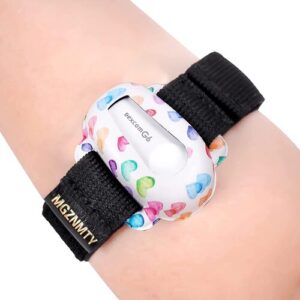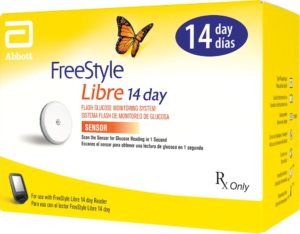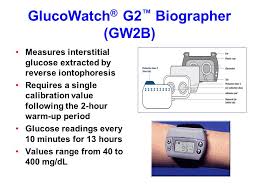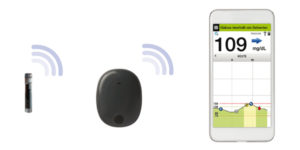Dexcom G6 Continuous Glucose Monitor
Dexcom G6 is one of the most advanced CGM (continuous glucose monitoring) systems available on the market. Developed and produced by Dexcom, a tech company based in San Diego, California, the Dexcom G6 offers seamless mobile app connectivity without the need to use a separate receiver.
It has also been approved for use by the FDA (Food and Drug Administration), primarily because its readings are accurate enough and the system does not require regular calibration using fingerstick tests.
Pros and cons of the Dexcom CGM G6
 Pros
Pros
- Users can wear sensors for up to 10 days (earlier models can be worn for only 7 days).
- Features a one-button plastic applicator that allows pain-free insertion.
- The needle is not visible as it retracts into the inserter.
- You can wear it discreetly under your clothing.
- Designed to alert you whenever your blood sugar level is trending high or low.
- Continuously keeps track of blood sugar levels in real-time.
- Results are displayed on a receiver device or smartphone app.
- The data sharing feature allows users to share data with up to 10 people.
- It is water-resistant, so it can be worn during baths, showers, or swimming.
- Features a vibrate-only mode for customizable alerts as well as alarms
- Tylenol (acetaminophen) does not affect blood glucose readings.
 Cons
Cons
- The “urgent low” (55 mg/dL) alert can’t be turned off.
- The sensor may stop working before 10 days elapse, or may fall off your body.
- Doesn’t restart easily if the sensor stops working before day 10.
- The system requires sensors and a transmitter, which can be quite costly, with or without insurance cover.
- Bluetooth connectivity may be lost from your insulin pump or phone, making the readings and insulin-related data less reliable.
- May be incompatible with some smartphones.
- The plastic auto-inserter is bulky and takes up significant storage space, especially when traveling.
What does the Dexcom G6 system entail?
The Dexcom G6 system was first approved for use by the Food and Drug Administration in March 2018. It was the first continuous glucose monitoring device to provide direct smartphone app connectivity without the need for a separate receiver. However, you can still opt to use either the smartphone app or receiver. Fortunately, the system does not require calibration for accuracy using fingerstick glucose tests.
Let’s explore what the system entails in detail:
· Transmitter
The transmitter is a thin gray part that functions as the system’s brain. It clicks on top of the sensor and is 30% thinner and smaller than the previous Dexcom model. Despite having a lower profile than the previous model, the new transmitter has a battery life of 3 months.
Featuring built-in Bluetooth connectivity, the Dexcom G6 transmits readings directly to the separate receiver, smartphone app or other compatible devices in 5-minute intervals. Moreover, the transmitter has a range of up to 20 feet.
· Auto inserter
Dexcom G6 features a new disposable auto-inserter design. It is a plastic, self-contained, spring-loaded auto-applicator. It does not require users to do anything other than press a button to insert a new sensor. It even allows for one-handed auto-insertions. Moreover, the sensors come preassembled into the inserter to ensure that the needles are not exposed.
The insertion process is easy and straightforward. You simply need to pull the adhesive off and place the sensor on your skin before pushing the orange button. What’s great is that the disposal applicator piece automatically separates from the sensor immediately after placing it on your body.
· Does not require fingersticks
Unlike previous versions, the Dexcom G6 doesn’t require regular fingerstick calibrations. The FDA has given it a nonadjunctive designation, which means that it can also be used in making treatment and dosing decisions without backup systems such as fingerstick tests.
Even though the Dexcom G6 system is factory calibrated, it still allows users to enter calibrations manually for additional confidence in accuracy.
· Sensor code
The sensor features a 4-digit code clearly printed on the adhesive backing. You simply need to enter the code into the separate receiver device or smartphone app before insertion. This helps trigger the “no calibration” feature.
Keep in mind that if this code is not entered or scanned, you’ll need to calibrate the sensor every 12 hours, as was necessary with the previous Dexcom G5 model.
· Young children
The G6 model is approved for 2-year-olds and up.
· Water-resistant 10-day wear
The G6 sensor is more accurate and can be worn for up to 10 days compared to the previous model’s 7-day wear.
The sensor now features a hard shutoff exactly at the 10-day mark. Therefore, the sensor can’t be extended for prolonged wear, as some people did with earlier models. This was laid out by the FDA in a letter to Dexcom, clearly describing specific requirements for Dexcom G6. Although the sensor can be started through some DIY methods, those methods are considered “off-label” because they are not endorsed by the Food and Drug Administration.
· Predictive alerts
The system will give you “Urgent Low Soon” alerts each time the sensor detects that your blood sugar levels are falling fast and expects it to fall to 55 mg/dL within the next 20 minutes. Although the other G6 alarms and alerts can be silenced, this alert cannot be turned off because it’s required by the FDA.
· Customizable alarms and alerts
Different alert preferences can be set for any time of day or night. The system also comes with a “Do Not Disturb” feature for vibration or audible alerts. However, the “Snooze” feature does not work on important alarms and alerts like “Transmitter/Sensor Failure” and “Urgent Low”.
· No Tylenol effect
Interference from medications that contain Tylenol (acetaminophen) has been a serious ongoing issue when it comes to continuous glucose monitoring. The good news is that the Tylenol effect is not an issue with the G6 model.
Dexcom G6 features a special membrane on the sensors that eliminates interference from medications containing Tylenol, which could yield false high blood sugar readings.
· Mobile app
The Dexcom G6 Mobile app starts displaying blood sugar results after warming up for 2 hours without showing any data. The app displays a circle with your real-time blood glucose level as well as the appropriate yellow, red, or gray color code showing whether you are “High”, “Low”, or “In Range”.
It also displays an arrow depending on the direction you’re currently trending.
A graph with blood sugar dots and other data like carbs, exercise, or insulin is displayed below the circle. If you want to see more than the most recent 3 hours of data, you simply need to turn your phone horizontally to view up to the past 24 hours of CGM data and navigate accordingly.
You can share CGM data with up to 10 people through the separate Dexcom G6 Follow app. Most importantly, data can be shared with your physician’s office through the Dexcom G6 CLARITY platform.
· Supports both Android and iOS
The Dexcom G6 app is compatible with Android and iOS smartphones, but some models may be incompatible. Be sure to go through Dexcom’s list of supported devices. Moreover, Dexcom says the system won’t send CGM data directly to Android or Apple watches without a mobile phone.
How accurate and reliable is the G6?
CGM performance is measured using MARD (mean absolute relative difference). With MARD, lower numbers reflect better accuracy. Data shows that the Dexcom G6 has a MARD of 9% with sustained reliability and accuracy over the time the sensors are worn, putting it considerably ahead of its competitors.
Dexcom G6 CLARITY software
Dexcom G6 CLARITY software allows you to view blood sugar data trends and share reports with your doctor and other healthcare professionals. It is available to customers both through the smartphone app and online at no additional cost.
To access the G6 CLARITY app, turn the orientation of your phone to horizontal and click on the green icon in the upper right corner.
Dexcom G6 CLARITY app displays your reports for the most recent 24 hours up to 3 months, average blood sugar for any number of days, as well as comparison charts designed to help you see trends during different periods.
For instance, if you recently started using a new insulin pump, you can see how your data for the past few weeks or months differs from the months or weeks prior.
Key features of Dexcom CLARITY software include:
· GMI (Glucose Management Indicator):
It estimates the clinical A1C result expected based on the user’s average glucose from the past 12 days of data. While it is not an accurate prediction, it can be used to get a good idea of where the user stands on the 3-month average.
· Time in range:
This displays the total percentage of time the user’s blood sugar levels are in the high, target, and low ranges. The “in-target” range is set at 70 to 180 mg/dL by default, but you can easily adjust it in settings.
Access to Clarity data can also be granted to doctors by simply authorizing this on the website or directly via the app. This allows doctors and other healthcare professionals to log in and use the data at no cost.
Using CLARITY’s overview reports is billable to your insurance provider, so doctors can get reimbursed for reviewing and interpreting your data through private insurers or Medicare. The CPT code, or billing code, is 95251.
How much does the Dexcom G6 cost?
A wide variety of private insurers in the US cover Dexcom continuous glucose monitors, and Medicare also started covering the Dexcom G6 as of mid-2022.
Note that benefits may vary by plan, and it is essential to check with your provider. You also need a prescription for the Dexcom G6 transmitter and sensors, so you must check with your doctor before buying.
Pricing details
Dexcom G6 supplies can be purchased at large retail pharmacies, including Rite Aid, Walgreens, and CVS. Prices vary, but most suppliers quote the price for a G6 transmitter at about $300 and a 3-pack box of sensors at just under $400.
The estimated annual retail costs without insurance are:
- $1,200 per year for G6 transmitters (4 G6 transmitters per year because each lasts 90 days)
- $4,800 per year for 12 boxes of G6 sensors (each box contains 3 sensors, and each lasts 10 days).
- Total estimated cost: $6,000 per year, or approximately $500 per month.
Is the Dexcom G6 CGM system right for me?
The G6 is an excellent CGM device for any child or adult with Type 1, Type 2, or gestational diabetes, given the importance of proper glucose management, especially during pregnancy.
So, what are the benefits of continuous glucose management?
- Helps avoid severe low or high blood sugar levels, especially hypoglycemia.
- Safeguards users from dangerous mistakes by guiding insulin dosing.
- Provides a sense of safety for patients who don’t feel lows or highs coming on.
- Improves diabetes management by increasing blood sugar “Time in range”
- Let’s you learn from the effects of your physical activity regimen and food on your body.
Note that CGM is extremely powerful when it comes to improving health outcomes. It is clear that diabetes patients can benefit, but recent clinical studies show that CGM is especially beneficial for specific groups, including older teens, young adults, and teens. One of the key benefits of CGM devices is the convenience they provide.
When should you consult your doctor?
It’s always important to talk to your diabetes care team about your individual goals for blood sugar levels. However, meeting with your endocrinologist and healthcare team is particularly helpful if you are experiencing any trends in lower or higher blood sugar levels, especially if you are experiencing any hypoglycemia symptoms.
The bottom line
Dexcom G6 is the most popular CGM system available on the market from a tech company that has built its reputation by integrating the latest and best CGM technologies for about 20 years.
It displays real-time data and features a variety of customizable alerts and alarms to predict out-of-range blood sugar levels. This allows for more proactive blood glucose management. With the G6’s high accuracy rating, compatibility with a wide variety of devices, and easy-to-use form factor, it is an awesome choice for anyone with diabetes. However, the Dexcom G6 can be quite expensive and frustrating when it doesn’t work as expected.
When you buy through links on our website, we may earn a small commission at no cost to you. Thanks for your support 🙂








 The FreeStyle Libre Flash holds an outstanding position for being the first non-invasive glucose monitoring device to be approved by the FDA. You need to install a sensor on the back of an upper arm before your start using FreeStyle Libre.
The FreeStyle Libre Flash holds an outstanding position for being the first non-invasive glucose monitoring device to be approved by the FDA. You need to install a sensor on the back of an upper arm before your start using FreeStyle Libre.
 EverSense is a non-invasive glucose monitoring device that offers Continuous Glucose Monitoring (CGM) properties. FDA approved it as the first CGM system.The EverSense CGM depends on a sensor implanted by a doctor beneath your skin. This means you have to undergo a minor operation to allow implantation. The device has a transmitter, over the sensor and above the skin, to allow data transmission. Users regard it as the best CGM in the market due to its accuracy.
EverSense is a non-invasive glucose monitoring device that offers Continuous Glucose Monitoring (CGM) properties. FDA approved it as the first CGM system.The EverSense CGM depends on a sensor implanted by a doctor beneath your skin. This means you have to undergo a minor operation to allow implantation. The device has a transmitter, over the sensor and above the skin, to allow data transmission. Users regard it as the best CGM in the market due to its accuracy.